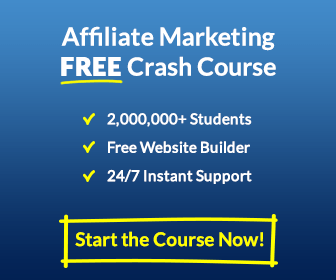One of the questions I’ve been asked the most by people who consider getting started with affiliate marketing is…
“Is It Hard to Make Money With Affiliate Marketing?”
If you’d like to know the answer to this question, please allow me to enlighten you…
Making money with affiliate marketing can be hard, especially if you’ve never pursued similar ventures. Just like with any worthwhile achievement, succeeding as an affiliate marketer involves a steep learning curve and tons of trial and error. However, having the right guidance and tools could shorten and smoothen the entire process.
Ultimately, the difficulty of every person’s journey to building an income online with affiliate marketing could vary greatly depending on a vast range of factors, such as:
- Niche
- Competition
- Demand
- Budget
- Consistency
- Quality of Work
- etc
For example, over the years, I’ve seen affiliate marketers striking a gold vein just a few months after launching their first business as well as others struggling to break the $1000/month barrier for over 4 years.
The good news is that out of all the factors that could influence the difficulty with which an affiliate marketer earns money, the most determining is just one!
However, before I delve into that subject, you must first get a clear picture of how the process of making money with affiliate marketing works.
The process of making money with affiliate marketing is comprised of 4 simple steps…
Step 1: Pick a Niche
A niche is basically the market in which you’ll be promoting affiliate products and it can be anything from weight loss and electronics to furniture and clothes.
Step 2: Build Digital Marketing Assets
A digital marketing asset is anything that can be leveraged towards communicating and interacting with your target audience over the internet, such as:
- Website
- Blog
- Youtube channel
- Instagram page
- Facebook group
- Email list
- etc
You can think of your digital marketing assets as the “storefront” of your affiliate business where all your affiliate promotions will be taking place.
Step 3: Gather Web Traffic
Web traffic is the bread and butter of your affiliate business and can be described as the total amount of people that interact with your digital marketing assets (e.g. Instagram followers, website visitors, email subscribers, Youtube viewers, etc).
Simply put, no web traffic = no potential consumers = no affiliate commissions.
Step 4: Promote Affiliate Offers
Once your digital marketing assets are in place and web traffic has started flowing in, you can start monetizing by promoting niche-relevant affiliate offers.
For instance, if your niche revolves around yoga, you could promote yoga workout routines, equipment, retreats, courses, etc.
Best Affiliate Marketing Courses
Best Affiliate Courses
The Key Factor to Affiliate Success
As previously mentioned, despite the fact that there are numerous factors contributing to how difficult making money with affiliate marketing could be, the most determining is just one…
This factor is Web Traffic.
Practically, the difficulty with which you’ll be earning money as an affiliate marketer depends on how easily you can get the affiliate offers you promote in front of the eyes of web traffic that might be interested in purchasing them.
That being said, the question “Is It Hard to Make Money With Affiliate Marketing?” could as well be rephrased to “Is Ii Hard to Gather Web Traffic?”.
The answer to this question is “It depends on the kind of web traffic you decide to utilize.”
Web traffic can be split into 2 main categories:
- Free Traffic
- & Paid Traffic
1. Free Traffic
Free traffic refers to traffic generated without spending money on running paid ads.
The two methods of cultivating free traffic utilized by most affiliate marketers (probably because they have a track record of being extremely effective for promoting affiliate offers) are:
- Content Marketing
- and Search Engine Optimization (SEO)
Content marketing is the process of consistently creating and publishing content that’s highly relevant to your target audience, such as:
- YouTube videos
- Blog posts
- Infographics
- Case studies
- Social media posts
- etc
For example, if your target audience is comprised of beginners to yoga, your content marketing strategy could revolve around recording YouTube videos sharing beginner-friendly information about yoga, such as:
- tips
- workouts
- nutrition plans
- poses
- breathing techniques
- etc
Ultimately, the more content you publish, the higher your chances of being found by people who might be interested in purchasing the affiliate offers you promote.
Not only that but publishing high-quality, helpful content boosts your credibility and trustworthiness, something that could, in turn, increase your audience’s conversion rates (the rates at which your audience purchases what you’re promoting).
Search Engine Optimization (SEO) is a combination of practices that can be leveraged towards optimizing your website so that search engines (Google, Yahoo, Yandex, etc) start displaying it at higher positions of their search results when specific keywords are queried.
The higher a website appears on a search engine’s search results for a given keyword, the more free traffic it receives.
For instance, as you can see in the image below, the website runnersworld.com appears in the 1st position of Google’s search results for the keyword “best running shoes”.

This basically means two things…
Firstly, runnersworld.com has performed better SEO for the keyword “best running shoes” than runningshoesguru.com which appears in the 2nd position, and fleetfeet.com which appears in the 3rd.
Secondly, runnersworld.com is most likely attracting much more free traffic for the keyword “best running shoes” than runningshoesguru.com and fleetfeet.com.
However, every upside has its downside…
While content marketing and SEO are perfect for attracting traffic to your affiliate offers without spending a single dime on paid advertising, they’re both pretty hard and time-consuming to implement, maintain, and scale.
You can think of it this way…
The less money you invest in generating traffic, the more time and effort you’ll have to invest.
If you require high-quality guidance on gathering free traffic via content marketing and SEO I strongly suggest that you check out two of my favorite affiliate marketing courses
2. Paid Traffic
Paid traffic refers to traffic generated via advertising promotions you’ve paid actual money to run, such as:
- Display: Banners, texts, or images placed on third-party websites
- Paid search: Ads displayed on search engines like Google & Yahoo
- Social media: Ads served to users on social media like Facebook & Instagram
- Sponsored: Paid content created and distributed by influencers
- Native: Ads consistent with the overall theme of the platform on which they appear
Contrary to free traffic that requires the investment of tons of time and effort to start kicking in, paid traffic is generated virtually instantaneously the same moment you get your paid ad campaigns up and running.
As such, establishing paid traffic is generally considered simpler, faster, and more hustle-free.
Furthermore, unlike free traffic that needs to be maintained regularly, paid traffic is much less hands-on in the sense that it’ll keep coming in for as long as it’s being funded.
Also, while scaling free traffic requires even more time and effort, scaling paid traffic can take place on-demand with merely a slight increase in your ad budget.
Lastly, paid ad campaigns usually involve much less technical work, less manpower, and less long-term planning than free traffic campaigns.
The main downside of leveraging paid ads is that you always run a certain amount of risk of completely wasting your money for nothing as there’s no guarantee whatsoever that the traffic you paid for will result in any actual sales.
And truth is that most beginners to paid ads lose money until they start getting the hang of the whole process.
If you’d like to start driving instant targeted traffic to your affiliate offers on-demand by utilizing paid ads, I strongly suggest that you take a look at two of the best affiliate courses on paid advertising
Affiliate marketing FAQs
Affiliate marketing is an online business model that involves promoting products or services created and distributed by third-party online merchants in exchange for getting paid a commission for each sale you refer.
In layman’s terms, affiliate marketing is the process of being compensated for helping businesses sell to more customers.
Here’s a bird’s eye view of how affiliate marketing works.
- You join a merchant’s affiliate program
- The merchant gives you a unique affiliate link that points to their e-shop
- You promote your unique affiliate link online (blog, forums, social media, paid ads, etc.)
- Every time someone clicks on your unique affiliate link and makes a purchase on the merchant’s e-shop, the merchant pays you a commission
There are thousands of successful affiliate marketers all around the world. Some of the most well-known ones are:
- Pat Flynn
- Matt Diggity
- Matthew Woodward
- Doug Cunnington
- & more
You can check out a roundup of my 17 favorite examples of affiliate success and their backstories right here.
- Billion-dollar industry
- Very low startup & operational expenses
- Huge income potential
- Flexible & versatile
- Passive income
- Simple to implement
- No technical background
- No customer support
- No physical setup
Affiliate marketers can be divided into five main income groups:
- Total beginners: $0 – $20,000 per year
- Low-level affiliates: $20,000 – $50,000 per year
- Intermediate affiliates: $50,000 – $100,000 per year
- High-level affiliates: $100,000 – $500,000 per year
- Super affiliates: $500,000+ per year
According to PayScale, the average annual income for affiliate marketers in the US is over $54,000 per year. Statistics reveal that 13% of affiliates earn more than $75,000 per year.
Some of the factors that influence how much you earn as an affiliate marketer include:
- seniority
- target niche
- available resources
- previous experience
- marketing efforts
- & overall mindset
Here’s a rough income growth timeline of a typical affiliate marketing business:
- months (0-3): no earnings
- months (3-6): first affiliate sale
- months (6-12): $100-$500 monthly
- months (12-18): $1000 monthly
- months (18-24): $3000+ monthly
This timeline isn’t a guarantee of future performance but rather a mere approximation of the income growth of an average affiliate business. Your own timeline could be shorter or longer than projected.
Over the years, I’ve seen aspiring affiliates striking a gold vein just a few months into the industry. On the other hand, I personally know people who’ve been struggling to grow their affiliate revenue to $1000 per month for several years.
Affiliate marketing is one of the most affordable money-making models out there.
Here’s a breakdown of everything you need to get started as an affiliate marketer along with their associated costs:
- web hosting & domain name: $2.95/month (Bluehost)
- keyword research tool: $49/month (Jaaxy)
- expert guidance: $49/month (Wealthy Affiliate)
- email autoresponder: Free for up to 1000 subs (MailerLite)
Please note that on top of expert guidance, Wealthy Affiliate also provides free access to hosting and a keyword research tool so you don’t have to purchase them separately.
Yes, you can do affiliate marketing without a website by promoting your affiliate links on other marketing channels, such as:
- Social Media
- Paid Ads
- YouTube
- Podcast
- etc.
The process of getting started with affiliate marketing can be broken down into the following four simple steps:
- Pick a niche
- Launch a blog
- Build an audience
- Promote affiliate products
No, you don’t.
Affiliate marketing is very simple to get started with by virtually anyone regardless of age, education, background, available capital, tech-savviness, professional network, etc.
In fact, most 6-figure affiliate marketers were no more experienced than you currently are when they first ventured into the affiliate marketing industry.
Nonetheless, being knowledgeable in fields like marketing, sales, content production, business management, etc., could help you reach your financial goals somewhat faster.
Conclusion
Summing up, the difficulty of making money with affiliate marketing depends mostly on your ability to send targeted web traffic to the affiliate offers you’re promoting…
Web traffic can be divided into the 2 following categories:
- Free Traffic
- Paid Traffic
Cultivating free traffic could take months or maybe even years of consistent effort but requires no monetary investment.
Paid traffic can be generated almost effortlessly as soon as you launch a paid ad campaign but maintaining it requires a steady stream of funding.
Optimally, you could experiment with both types of traffic and stick with the one that seems to be generating the best returns on your investments.
However, please note that the process of successfully leveraging either paid or free traffic towards making money online as an affiliate marketer, involves a steep learning curve, a lot of trial and error, consistent work, and massive patience.
Having said that, if you’d like to short-circuit and streamline your journey to affiliate success, I strongly suggest that you check out my roundup of The Best Affiliate Marketing Courses.
Do you have any additional questions?
Leave a comment right below or contact me right here.
I’ll be more than happy to help you out!
All the best,
Harry, Founder & Editor at dearboss-iquit.com




